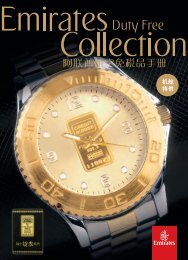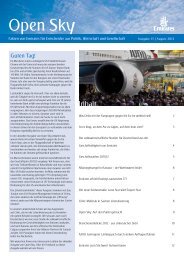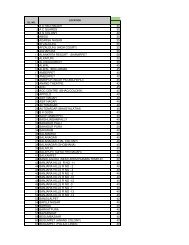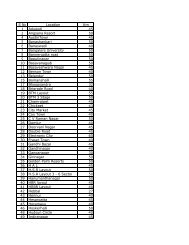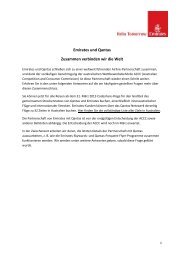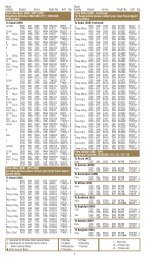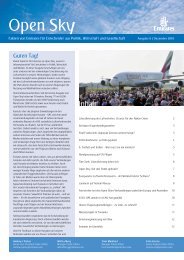Annual Report 2008-2009 - Emirates.com
Annual Report 2008-2009 - Emirates.com
Annual Report 2008-2009 - Emirates.com
Create successful ePaper yourself
Turn your PDF publications into a flip-book with our unique Google optimized e-Paper software.
<strong>Emirates</strong><br />
108<br />
35. Financial risk management (continued)<br />
(ii) Market risk<br />
<strong>Emirates</strong> is exposed to market risk, which is the risk that the fair value or future cash flows of a financial instrument will fluctuate<br />
because of changes in market prices. Market risk <strong>com</strong>prises three types of risk - fuel price risk, currency risk and interest rate risk.<br />
Fuel price risk<br />
<strong>Emirates</strong> is exposed to volatility in the price of jet fuel and closely monitors the actual cost against the forecast cost. At the<br />
<strong>com</strong>mencement of the year, <strong>Emirates</strong> had certain financially settled derivatives indexed to crude oil to manage the upside price risk.<br />
These instruments had features which leverage the risk to <strong>Emirates</strong> when oil prices decline. <strong>Emirates</strong> uses swaps and options to<br />
mitigate some of this downside risk. During the year, <strong>Emirates</strong> has significantly reduced its open positions and at the balance sheet<br />
date has minimal exposure to fuel price risk (Note 32). To manage the upside price risk, <strong>Emirates</strong> utilises <strong>com</strong>modity futures and<br />
options to achieve a level of control over higher jet fuel costs so that profitability is not adversely affected.<br />
Currency risk<br />
<strong>Emirates</strong> is exposed to the effects of fluctuation in the prevailing foreign currency exchange rates on its financial position and cash<br />
flows. Exposure arises due to exchange rate fluctuations between the UAE Dirham and other currencies generated from <strong>Emirates</strong><br />
revenue earning and borrowing activities. Long term debt obligations are mainly denominated in UAE Dirhams, the functional<br />
currency or in US Dollars to which the UAE Dirham is pegged. Currency exposure exists on the Singapore Dollar bond, the<br />
summarised quantitative data for which is available in Note 21. Senior management monitors currency positions on a regular basis.<br />
<strong>Emirates</strong> is in a net payer position with respect to the US Dollar and in a net surplus position for other currencies. Currency<br />
surpluses are converted to US Dollar and UAE Dirham funds. Currency risks arises mainly from <strong>Emirates</strong> revenue earning activities in<br />
UK Pounds, Euro, Australian Dollars and Japanese Yen. Currency risks are hedged using forwards and options, as appropriate, as<br />
well as by way of a natural hedge between foreign currency inflows and outflows.<br />
Interest rate risk<br />
<strong>Emirates</strong> is exposed to the effects of fluctuations in the prevailing levels of interest rates on borrowings and investments. Exposure<br />
arises from interest rate fluctuations in the international financial markets with respect to interest cost on its long term debt<br />
obligations, operating lease rentals and interest in<strong>com</strong>e on its cash surpluses. The key reference rates based on which interest<br />
costs are determined are LIBOR, EIBOR for UAE Dirhams and SIBOR for Singapore Dollars. Summarised quantitative data is<br />
available in Note 20 for interest cost exposures.<br />
Borrowings taken at variable rates expose <strong>Emirates</strong> to cash flow interest rate risk while borrowings issued at fixed rates expose<br />
<strong>Emirates</strong> to fair value interest rate risk. <strong>Emirates</strong> targets a balanced portfolio approach, whilst nevertheless taking advantage of<br />
opportune market movements, by hedging around half of its net interest rate exposure going forward, using appropriate hedging<br />
solutions including interest swaps. Variable rate debt and cash surpluses are mainly denominated in UAE Dirhams and US Dollars.





